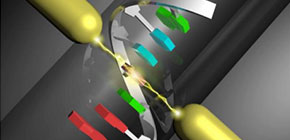
Rethinking Existing Method Opens New Doors for Cancer Diagnostics
Osaka University researchers successfully use single-molecule sequencing method to investigate fluid dynamics of a single DNA molecule in solution
All diseases have a genetic component. Advances in understanding the genetic mechanisms behind these disease enables the development of early diagnostic tests, new treatments, or interventions to prevent disease onset or minimize disease severity. However, much remains to be learned when it comes to the extent to which genes contribute to disease.
Cancer can be diagnosed by identifying DNA and microRNA base sequences that have the same base length yet differ in a few base sequences, if the abundance ratios of these slightly deviant base sequences can be determined. However, while some current DNA sequencers using ionic current as a probe are expected to be able to determine the amount of DNA in principle, results of quantitative analysis have not yet been reported.
“Personalized medicine applications require a method that does not involve chemical modification using expensive reagents and protracted polymerase chain reaction (PCR) amplification, to allow high throughput at low cost,” explains Takahito Ohshiro, the first author of a new Osaka University study.
In the study, the team led by Masateru Taniguchi used current-tunneling measurements to record the single-molecule conductances of the base molecules. The tunneling currents flowing through single molecule were measured by gold electrodes – separated 0.75 nm apart from each other, equivalent to the size of a DNA base molecule – using a mechanically controllable break-junction. Single-molecule signals were then obtained in forms of current spikes, whose height represents the electron transport through a molecule.
The team successfully determined the entire base sequences – without having to chemically modify DNA or amplify it by PCR – of four types of DNA corresponding to the let -7 microRNA, a 22-base cancer marker. In addition, they could count the numbers of molecules in a solution to determine the abundance ratios of two DNA strands that differ by a single base sequence. The study was published in Scientific Reports .
“Because the single-molecule sequencing method detects differences in the electronic states of molecules in terms of single-molecule conductances, it may also be applied to the analysis of microRNA and RNA molecules that include four base molecules and peptides that include 20 kinds of amino acids,” Taniguchi adds. “Also, as the method can detect chemically modified base molecules and amino acids, it represents a substantive step toward realizing personalized genomic diagnosis of cancer and other diseases.”

Image: Operating principle of single-molecule sequencing

Video: Operating principle of single-molecule quantum sequencing
To learn more about this research, please view the full research report entitled "Quantitative analysis of DNA with single-molecule sequencing" a t this page of Scientific Reports .
Related links

